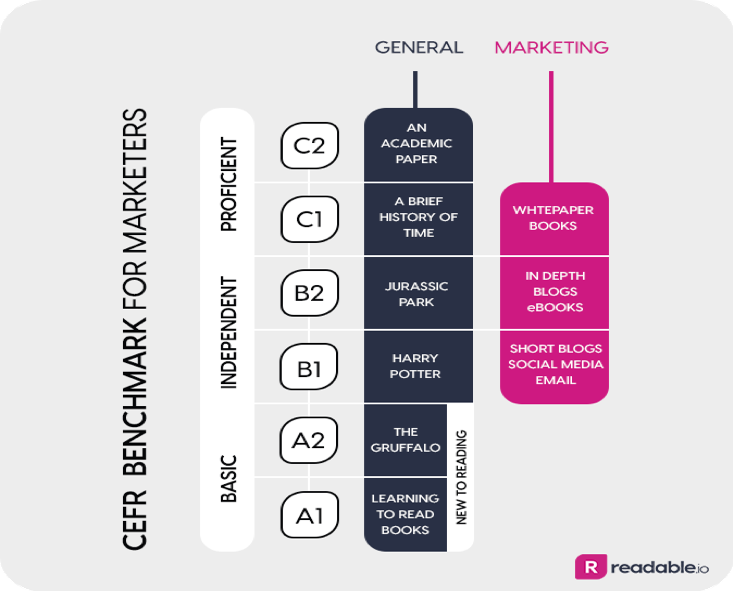
At its purest, readability is about keeping things simple. It’s about explaining things in as straightforward terms as possible. Content marketers deliver a wealth of ideas and information, but it’s not always presented in the best way. Among the potential problem areas:
- Length of words and sentences
- Grammar
- Structure of content
- Use of language
Poor readability is a signal that you’re not looking after your audience. It can mean you:
- Spend a lot of time, money, and other resources producing material that doesn’t fit its purpose
- Don’t have an engaged audience
- Lose audience trust, which diminishes customers’ relationship with your business
- Find your customers taking their business elsewhere
- Lose revenue
When the Dutch government used readability tools, it found its content’s readability level (C1 – see scale below) was too high for the majority of readers in the Netherlands, who are at a B1 readability level.

Given that most readers could not fully understand the content distributed by the government, it was not only a waste of taxpayer money but it could have hurt people’s well-being if they couldn’t understand the content related to topics such as social security.
9 tips for better readability or 9 steps to ensure that your audience is more likely to consume and engage with your content
1.Have a customer focus
Create content that:
- Is genuinely useful to the reader
- Is relatable
- Answers a question or solves a problem
- Informs, entertains, or educates (preferably all three)
The relatable point is an essential one. Too much content, particularly on websites, is me-me-me – the brand only talks about itself. Avoid doing that at all costs. For example, turn the focus of how you do something to how your readers can benefit by adopting the same practice.
2.Get a baseline score
Once you have your first draft ready, it’s time to determine its readability score. You can use one of several free and paid tools. With these tests, you can learn the Flesch-Kincaid U.S. grade level along with other standard readability assessments, such as the Flesch Reading Ease, Gunning Fog Index, CEFR, and SMOG Index. Some highlight word by word (or sentence by sentence), the potential readability challenges.
3.Revise to achieve correct reading level
As a general rule of thumb, we aim for a reading level of grade eight for our blog posts – which is the level of a 14- or 15-year-old – to ensure that a wide audience can understand our content. We focus on grade 10 for e-books and grade 12 for white papers and books.
4.Shorten your sentences
The No. 1 element that readability algorithms agree on is that long sentences are bad. Thankfully, it’s an easy fix – shorten your sentences.
Full stops and bullet points are your friend. Use them, and use them often. You’ll soon have content that:
- Can be easily read online
- Doesn’t drag and drain your reader
- Is structured in a reader-friendly way
5.Reduce the number of long words
Long words are another red flag for readability. Where possible, look for shorter alternatives (e.g., you might replace the word “alternatives” with “options”).
6.Scrub your copy of buzzwords, geekspeak, jargon, and acronyms
Resist the temptation to fill your content with buzzwords, geekspeak, jargon, or acronyms. They limit the content to those who are already in the know. If you must use challenging terms, explain them.
7.Don’t overuse adverbs
People frequently tend to liberally overuse adverbs, eventually causing sentences to be really cluttered.
If you take all of the adverbs out of that previous sentence, how much better does it sound?
Like anything in life, moderation is key.
8.Set a balance between formal and conversational
In conversational content, I aim to make it feel like I’m talking directly with you. It makes the reading experience more personal. It also feels more natural to me to write this way, even after years of writing for a B2B audience.
Just because you’re writing for business doesn’t mean you have to write with no personality. Make sure the flow of copy is natural and not forced.
In some cases, conversational or informal tones are not appropriate (e.g., a privacy policy). But formal doesn’t mean you should abandon readability. Clear language always wins, formal or conversational.
9.Seek feedback and proofread
Common-sense time, again. As many pairs of eyes as possible should read a document before it goes live. As a writer, you can be too close to the text. Another person can give you the perspective of a reader and point out areas of improvement.
Readability and content marketing are about the same three principles:
- Keep your audience at the center of everything you do.
- Inform, educate, or entertain your audience.
- Keep it simple.
Keeping things simple isn’t easy, but practice makes better content. The more you stick to readability principles, the more readily your audience will consume and engage with your content.
This is a summary. Read the full article HERE.
